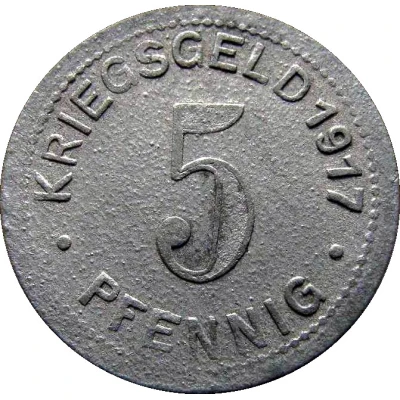


© Victor (Ukraine)
5 Pfennigs - Elberfeld
1917 year| Zinc | 1.81 g | 18.0 mm |
| Issuer | City of Elberfeld (Prussian province of Rhine) |
|---|---|
| Emperor | William II (Wilhelm II) (1888-1918) |
| Type | Standard circulation coin |
| Year | 1917 |
| Value | 5 Pfennigs (5 Pfennige) (0.05) |
| Currency | Mark (1914-1924) |
| Composition | Zinc |
| Weight | 1.81 g |
| Diameter | 18.0 mm |
| Thickness | 1 mm |
| Shape | Round |
| Technique | Milled |
| Orientation | Medal alignment ↑↑ |
| Demonetized | Yes |
| Updated | 2024-10-04 |
| Numista | N#16397 |
|---|---|
| Rarity index | 44% |
Reverse
Pearl rim, legend surrounding denomination centered
Script: Latin
Lettering:
KRIEGSGELD 1917
5
∙ PFENNIG ∙
Edge
Plain
Comment
Issuing authority: [Stadt, Rheinprovinz]Interesting fact
The 5 Pfennigs - Elberfeld 1917 coin was minted during a time of economic turmoil in Germany, known as the "Inflationary Period" (1914-1923). During this time, the value of the German mark (the national currency) plummeted, and prices for everyday goods skyrocketed. As a result, many Germans turned to alternative forms of currency, such as local emergency currencies like the 5 Pfennigs - Elberfeld 1917 coin. This coin, made of zinc and weighing 1.81 grams, was issued by the City of Elberfeld in the Prussian province of Rhine and was used as a substitute for the rapidly devaluing national currency. Despite its humble appearance, this coin serves as a tangible reminder of a tumultuous period in German history.
Price
| Date | Mintage | VG | F | VF | XF | AU | UNC |
|---|---|---|---|---|---|---|---|
| 1917 | - | - | - | - | - | - |
Values in the table are based on evaluations by sales realized on Internet platforms. They serve as an indication only for 5 Pfennigs - Elberfeld 1917 coin.